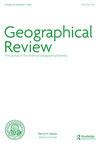城市形态与当地社区对COVID-19的时空脆弱性
IF 1.4
3区 社会学
Q2 GEOGRAPHY
引用次数: 8
摘要
本文研究了美国犹他州盐湖城县城市形态对Covid-19在当地社区传播影响的时空动态。我们确定了三种类型的社区——少数民族社区、传统城市和郊区社区以及新郊区社区,并确定了2020年3月至2021年9月的三个阶段,分别反映了初始阶段、爆发阶段和恢复阶段。传统城市和郊区社区的风险最低,少数民族社区在发病初期和疫情暴发阶段受到严重影响,偏远郊区社区在疫情暴发和恢复阶段受到的影响最大。回归进一步揭示了城市形态在大流行病中的作用。高密度的城市土地使用是导致疾病传播的主要密度因素。在初始阶段,街道连通性和可步行性等交通因素有助于局部传播,而在爆发阶段,土地使用混合是催化剂。一项全面的紧凑型发展可能会抵消这些对当地公共卫生的负面影响,它对恢复阶段当地复原力的贡献也得到证实。因此,紧凑型发展对于建设城市复原力仍然很有价值,适当的规划和政策可以抵消大流行病的潜在不利影响。本文章由计算机程序翻译,如有差异,请以英文原文为准。
URBAN FORM AND SPATIOTEMPORAL VULNERABILITY OF LOCAL COMMUNITIES TO COVID-19
ABSTRACT This paper investigates spatiotemporal dynamics of the effects of urban form on the Covid-19 spread within local communities in Salt Lake County, Utah, in the United States. We identify three types of communities—minority, traditional urban and suburban, and new suburban—and three stages throughout March 2020—September 2021, reflecting the initial, outbreak, and recovery stages. While the traditional urban and suburban communities experience the least risk of Covid-19, minority communities are severely impacted in the initial and outbreak stages, and remote suburban communities are primarily affected in the outbreak and recovery stages. The regression further reveals the role of urban form in the pandemic. High-density urban land use is the main density factor contributing to the disease’s spread. In the initial stage, mobility factors such as street connectivity and walkability contribute to the local spread, while land use mixture is the catalyst in the outbreak stage. A comprehensive compact development might offset these negative effects on local public health, and its contribution to local resilience in the recovery stage is also confirmed. Thus, compact development is still valuable for building urban resilience, and proper planning and policies can offset the potential adverse effects of pandemics.
求助全文
通过发布文献求助,成功后即可免费获取论文全文。
去求助
来源期刊

Geographical Review
GEOGRAPHY-
CiteScore
4.80
自引率
10.00%
发文量
24
期刊介绍:
One of the world"s leading scholarly periodicals devoted exclusively to geography, the Geographical Review contains original and authoritative articles on all aspects of geography. The "Geographical Record" section presents short articles on current topical and regional issues. Each issue also includes reviews of recent books, monographs, and atlases in geography and related fields.
 求助内容:
求助内容: 应助结果提醒方式:
应助结果提醒方式:


